This is an old revision of this page, as edited by Culturehistory (talk | contribs) at 04:58, 16 November 2020 (→Gamelan outside Indonesia). The present address (URL) is a permanent link to this revision, which may differ significantly from the current revision.
Revision as of 04:58, 16 November 2020 by Culturehistory (talk | contribs) (→Gamelan outside Indonesia)(diff) ← Previous revision | Latest revision (diff) | Newer revision → (diff)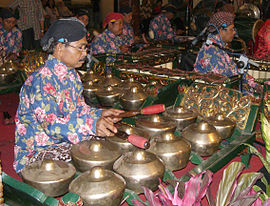 A gamelan player playing bonang. Gamelan Yogyakarta style during a Javanese wedding A gamelan player playing bonang. Gamelan Yogyakarta style during a Javanese wedding | |
| Classification | |
|---|---|
| Developed | Indonesia |
| Playing range | |
| Pelog, Slendro, Pathet, Cengkok, Seleh, Sekaran, Imbal, kotekan, Gatra, Colotomy, Gendhing structures, Irama, Gamelan notation | |
| Related instruments | |
| bonang, kenong, canang, keromong, kromong, kethuk, trompong/terompong, rejong, talempong, chalempung, caklempong/caklempung, khong wong yai/khong wong lek, khong toch/ khong thom, khong vong, krewaing/krewong | |
| More articles or information | |
| Gamelan ensemble | |
|---|---|
| Stylistic origins | Music of Indonesia (Java, Sunda and Bali ) |
| Cultural origins | Indonesia |
| Typical instruments | Gamelan • Gong • Bonang • Gambang • Gendèr • Kemanak • Kendang • Kepyak • Reyong • Gangsa • Kenong/Kethuk • Peking • Saron • Siter • Slenthem • Suling |
 Various hanging Gongs (gong ageng, gong suwukan, kempul) of Gamelan in Indonesia Various hanging Gongs (gong ageng, gong suwukan, kempul) of Gamelan in Indonesia |
| Music of Indonesia |
| Genres |
|---|
| Specific forms |
|
|
|
|
| Regional music |
Gamelan (/ˈɡæməlæn/) (Template:Lang-jv) (Template:Lang-su) (Template:Lang-ban) is the traditional ensemble music of the Javanese, Sundanese, and Balinese peoples of Indonesia, made up predominantly of percussive instruments. The most common instruments used are metallophones played by mallets and a set of hand-played drums called kendhang which register the beat. The kemanak (a banana shaped idiophone) and gangsa (another metallophone) are commonly used gamelan instruments in Java. Other instruments include xylophones, bamboo flutes, a bowed instrument called a rebab, and even vocalists named sindhen.
Although the popularity of gamelan has declined since the introduction of pop music, gamelan is still commonly played on formal occasions and in many traditional Indonesian ceremonies. For most Indonesians, gamelan is an integral part of Indonesian culture.
Terminology
The word gamelan comes from the low Javanese word gamel (ꦒꦩꦼꦭ꧀), which may refer to a type of mallet used to strike instruments or the act of striking with a mallet. The gamelan in the Sundanese is Degung (ᮓᮨᮌᮥᮀ), the word Degung apparently is an old Sundanese term, which refers to gongs and Gong ensembles. For this reason, the words degung and gong are essentially synonyms for the word gamelan. At the same time, the expression Gamelan degung may be a way to point at a gamelan ensemble tuned to degung scale. The term karawitan (ꦏꦫꦮꦶꦠꦤ꧀) refers to classical gamelan music and performance practice, and comes from the word rawit (ꦫꦮꦶꦠ꧀), meaning 'intricate' or 'finely worked'. The word derives from the Javanese word of Sanskrit origin, rawit, which refers to the sense of smoothness and elegance idealized in Javanese music. Another word from this root, pangrawit (ꦥꦁꦫꦮꦶꦠ꧀), means a person with such sense, and is used as an honorific when discussing esteemed gamelan musicians. The high Javanese word for gamelan is gangsa (ꦒꦁꦱ), formed either from the words tembaga (ꦠꦼꦩ꧀ꦧꦒ) and rejasa (ꦫꦼꦗꦱ) referring to the materials used in bronze gamelan construction (copper and tin), or tiga (ꦠꦶꦒ) and sedasa (ꦱꦼꦢꦱ) referring to their proportions (three and ten).
History

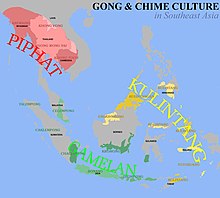
The gamelan predates the Hindu-Buddhist culture that dominated Indonesia in its earliest records and thus represents an indigenous art form. In contrast to the heavy Indian influence in other art forms, the only obvious Indian influence in gamelan music is in the Javanese style of singing, and in the themes of the Wayang kulit (shadow puppet plays).
In Javanese mythology, the gamelan was created by Sang Hyang Guru in Saka era 167 (c. AD 230), the god who ruled as king of all Java from a palace on the Maendra mountain in Medang Kamulan (now Mount Lawu). He needed a signal to summon the gods and thus invented the gong. For more complex messages, he invented two other gongs, thus forming the original gamelan set.
The earliest image of a musical ensemble is found on the bas-relief of the 8th century Buddhist monument of Borobudur, Central Java. The Borobudur's musicians play lute-like stringed instruments, kendang drums, suling flutes, small cymbals and bells. Some of these musical instruments are indeed included in a complete gamelan orchestra. Musical instruments such as the bamboo flute, bells, drums in various sizes, lute, and bowed and plucked string instruments were identified in this image. However it lacks metallophones and xylophones. Nevertheless, the image of this musical ensemble is suggested to be the ancient form of the gamelan.
The instruments developed into their current form during the Majapahit Empire. According to the inscriptions and manuscripts dated from the Majapahit period, the kingdom even had a government office in charge of supervising the performing arts, including the gamelan. The arts office oversaw the construction of musical instruments, as well as scheduling performances at the court.
In the palaces of Java the oldest known ensembles, Gamelan Munggang and Gamelan Kodok Ngorek, are apparently from the 12th century. These formed the basis of a "loud style" of music. In contrast, a "soft style" developed out of the kemanak tradition and is related to the traditions of singing Javanese poetry, in a manner often believed to be similar to the chorus that accompanies the modern bedhaya dance. In the 17th century, these loud and soft styles mixed, and to a large extent the variety of modern gamelan styles of Bali, Java, and Sunda resulted from different ways of mixing these elements. Thus, despite the seeming diversity of styles, many of the same theoretical concepts, instruments, and techniques are shared between the styles.
Instruments
A gamelan is a multi-timbre ensemble consisting of metallophones, xylophones, flutes, gongs, voices, as well as bowed and plucked strings. The hand-played drum called kendhang controls the tempo and rhythm of pieces as well as transitions from one section to another, while one instrument gives melodic cues to indicate treatment or sections of a piece. Some of the instruments that make up a gamelan in present-day Central Java are shown below:
- Instruments
-
 Bonang
Bonang
-
 Gendèr
Gendèr
-
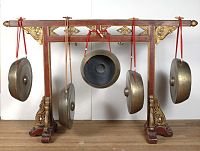 Gong
Gong
-
 Kendang
Kendang
-
 Kenong/Kethuk
Kenong/Kethuk
-
 Demung
Demung
-
 Peking
Peking
-
 Saron
Saron
-
 Slenthem
Slenthem
-
 Gambang
Gambang
-
 Suling or Seruling
Suling or Seruling
-
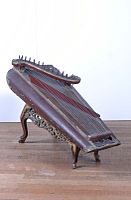 Siter or Celempung
Siter or Celempung
-
 Kemanak
Kemanak
-
 Rebab
Rebab
Varieties
See also: List of gamelan varietiesVarieties of gamelan are distinguished by their collection of instruments and use of voice, tunings, repertoire, style, and cultural context. In general, no two gamelan ensembles are the same, and those that arose in prestigious courts are often considered to have their own style and tuning. Certain styles may also be shared by nearby ensembles, leading to a regional style.
The varieties are generally grouped geographically, with the principal division between the styles favored by the Balinese, Javanese, and Sundanese peoples. The Madurese also had their own style of gamelan, although it is no longer in use, and the last orchestra is kept at the Sumenep palace. One important style of Sundanese gamelan is Gamelan Degung, which uses a subset of gamelan instruments with a particular mode of pelog scale. Balinese gamelan is often associated with the virtuosity and rapid changes of tempo and dynamics of Gamelan gong kebyar, its best-known style. Other popular Balinese styles include Kecak, a theatrical dance and music form also known as the "monkey chant." Javanese gamelan, largely dominated by the courts of the 19th century central Javanese rulers, each with its own style, is known for a slower, more meditative quality than the gamelan music of Bali. Javanese gamelan can be made from iron or brass; instruments made of cast bronze are considered the best quality.
Outside the main core on Java and Bali, gamelan has spread through migration and cultural interest, new styles sometimes resulting as well. The variety of gamelan can befound in over 25 countries outside Indonesia, presenting both traditional and experimental repertoire.
In oral Javanese culture distinctions are made between complete or incomplete, archaic and modern, and large standard and small village gamelan. The various archaic ensembles are distinguished by their unique combinations of instruments and possession of obsolete instruments such as the bell-tree (byong) in the 3-toned gamelan kodhok ngorek. Regionally variable village gamelan are often distinguished from standard gamelan (which have the rebab as the main melodic instrument) by their inclusion of a double-reed wind (selompret, slompret, or sompret) in addition to variable drum and gong components, with some also including the shaken bamboo angklung.
- Variants
-
 Sundanese Gamelan Degung being played in Museo Nacional de las Culturas Mexico, Indra Swara group
Sundanese Gamelan Degung being played in Museo Nacional de las Culturas Mexico, Indra Swara group
-
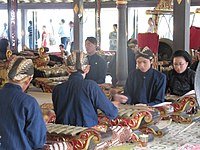 Javanese gamelan being played in Keraton Yogyakarta
Javanese gamelan being played in Keraton Yogyakarta
-
 Javanese gamelan being played in Surakarta, Central Java
Javanese gamelan being played in Surakarta, Central Java
-
 Balinese women gamelan Gong Kebyar
Balinese women gamelan Gong Kebyar
-
 Balinese gamelan being played in Kuta
Balinese gamelan being played in Kuta
-
 Sundanese Gamelan Degung
Sundanese Gamelan Degung
Cultural context

In Indonesia, gamelan often accompanies dance, wayang puppet performances, or rituals and ceremonies. Typically players in the gamelan will be familiar with dance moves and poetry, while dancers are able to play in the ensemble. In wayang, the dalang (puppeteer) must have a thorough knowledge of gamelan, as he gives the cues for the music. Gamelan can be performed by itself – in "klenengan" style, or for radio broadcasts – and concerts presentation are common in national arts conservatories founded in the middle of the 20th century.
Gamelan's role in rituals is so important that there is a Javanese saying, "It is not official until the gong is hung". Some performances are associated with royalty, such as visits by the sultan of Yogyakarta. Certain gamelans are associated with specific rituals, such as the Gamelan Sekaten, which is used in celebration of Mawlid an-Nabi (Muhammad's birthday). In Bali, almost all religious rituals include gamelan performance. Gamelan is also used in the ceremonies of the Catholic church in Indonesia. Certain pieces are designated for starting and ending performances or ceremonies. When an "ending" piece (such as "Udan Mas") is begun, the audience will know that the event is nearly finished and will begin to leave. Certain pieces are also believed to possess magic powers, and can be used to ward off evil spirits.
Gamelan is frequently played on the radio. For example, the Pura Pakualaman gamelan performs live on the radio every Minggu Pon (a day in the 35-day cycle of the Javanese calendar). In major towns, the Radio Republik Indonesia employs professional musicians and actors, and broadcast programs of a wide variety of gamelan music and drama.
In the court tradition of central Java, gamelan is often played in the pendopo, an open pavilion with a cavernous, double-pitched roof, no side walls, and a hard marble or tile floor. The instruments are placed on a platform to one side, which allows the sound to reverberate in the roof space and enhances the acoustics.
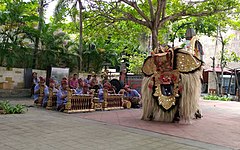
In Bali, the Gamelan instruments are all kept together in a balé, a large open space with a roof over the top of it and several open sides. Gambelan (the Balinese term) are owned by a banjar, nobility or temples and kept in their respective compounds.
In case of banjar ownership the instruments are all kept there together because people believe that all the instruments belong to the community as a whole and that no one person has ownership over an instrument. Not only is this where the instruments are stored, but this is also the practice space for the sekaha (Gamelan orchestra group). The open walls allow for the music to flow out into the community where the rest of the people may enjoy it. Balinese gamelan cannot be heard inside closed rooms, because it easily crosses the threshold of pain. This does not apply to small ensembles like a gamelan gendér.
The sekaha is led by a single instructor whose job it is in the community to lead this group and to come up with new pieces. When they are working on a new piece, the instructor will lead the group in practice and help the group form the new music as they are practicing. When the instructor creates a new song, he leaves enough open for interpretation that the group can improvise, so the group will write the music as they practice it.
There are many styles in Balinese gamelan. Kebyar is one of the most recent ones. Some Balinese gamelan groups constantly change their music by taking older pieces they know and mixing them together, as well as trying new variations of the music. Their music constantly changes because they believe that music should grow and change; the only exception to this is with their most sacred songs which they do not change. A single new piece of music can take several months before it is completed.
Men and women usually perform in separate groups, with the exception in Java of the pesindhen, the female singer who performs with male groups.
In the twenty-five countries outside Indonesia that have gamelan, music performed in a concert context or as part of ceremonies for expat communities may also accompany dance or wayang.
Tuning

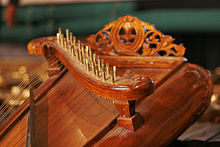
The tuning and construction of a gamelan orchestra is a complex process. Javanese gamelan use two tuning systems: sléndro and pélog. There are other tuning systems such as degung (exclusive to Sunda, or West Java, similar with Japanese ryukyuan scale), and madenda (similar to a Japanese hirajoshi scale). In central Javanese gamelan, sléndro is a system with five notes to the octave, with large intervals, while pélog has seven notes to the octave, with uneven intervals, usually played in five note subsets of the seven-tone collection. A full gamelan will include a set of instruments in each tuning, and classically only one tuning is used at a time. The precise tuning used differs from ensemble to ensemble, and gives each ensemble its own particular flavour. A set of gamelan instruments will be tuned to the same set of notes, but the tuning will vary from one gamelan to the next, including variations in the size of intervals.
Colin McPhee, a Canadian composer who spent much time in Bali, remarked, "Deviations in what is considered the same scale are so large that one might with reason state that there are as many scales as there are gamelans." This view is contested, however, by some teachers of gamelan, and there have been efforts to combine multiple ensembles and tuning structures into one gamelan to ease transportation at festival time. One such ensemble is gamelan Manikasanti, which can play the repertoire of many different ensembles.
Balinese gamelan instruments are built in pairs that are tuned slightly apart to produce interference beats, ideally at a consistent speed for all pairs of notes in all registers. This concept is referred to as "ombak," translating to "wave," communicating the idea of cyclical undulation. One instrument, tuned slightly higher, is thought of as the "inhale," and the other, slightly lower, is called the "exhale." When the inhale and the exhale are combined, beating is produced, meant to represent the beating of the heart, or the symbol of being alive. It is thought that this contributes to the "shimmering" sound of Balinese gamelan ensembles. In the religious ceremonies that contain gamelan, these interference beats are meant to give the listener a feeling of a god's presence or a stepping stone to a meditative state. The scale roughly approximates that of the phrygian mode of the Western major scale (E-E on the white keys of the piano), with the notes EFGBC corresponding to the note positions 12356 in the slendro scale used by most gamelan.
In addition to non-western scales, Javanese gamelan uses a combination of tempo and density known as Irama, relating how many beats on the saron panerus instrument there are to notes in the core melody or balungan; density is considered primary.
Notation
Further information: Musical notation § IndonesiaGamelan music is traditionally not notated and began as an oral tradition. In the 19th century, however, the kraton (palaces) of Yogyakarta and Surakarta developed distinct notations for transcribing the repertoire. These were not used to read the music, which was memorized, but to preserve pieces in the court records. The Yogyanese notation is a checkerboard notation, which uses six or seven vertical lines to represent notes of higher pitch in the balungan (melodic framework), and horizontal lines which represent the series of beats, read downward with time. The fourth vertical line and every fourth horizontal line (completing a gatra) are darkened for legibility. Symbols on the left indicate the colotomic or metric structure of gongs and so forth, while specific drum features are notated in symbols to the right. The Solonese notation reads horizontally, like Western notation, but does not use barlines. Instead, note values and rests are squiggled between the notes.
Today this notation is relatively rare, and has been replaced by kepatihan notation, which is a cipher system. Kepatihan notation developed around 1900 at the kepatihan Palace in Surakarta, which had become a high-school conservatory. The pitches are numbered (see the articles on the scales slendro and pélog for an explanation of how), and are read across with dots below or above the numbers indicating the register, and lines above notes showing time values; In vocal notation, there are also brackets under groups of notes to indicate melisma. Like the palace notation, however, Kepatihan records mostly the balungan part and its metric phrases as marked by a variety of gongs. The other parts are created in real time, and depend on the knowledge each musician has of his instrument, and his awareness of what others are playing; this "realization" is sometimes called "garap." Some teachers have also devised certain notations, generally using kepatihan principles, for the cengkok (melodic patterns) of the elaborating instruments. Some ethnomusicologists, trained in European music, may make transcriptions onto a Western staff. This entails particular challenges of tuning and time, sometimes resulting in unusual clefs.
Influence on Western music

The gamelan has been appreciated by several western composers of classical music, most famously Claude Debussy, who heard a Javanese gamelan in the premiere of Louis-Albert Bourgault-Ducoudray's Rhapsodie Cambodgienne at the Paris Exposition of 1889 (World's Fair). The work had been written seven years earlier in 1882, but received its premiere only in 1889. The gamelan Debussy heard in it was in the slendro scale and was played by Central Javanese musicians. Despite his enthusiasm, direct citations of gamelan scales, melodies, rhythms, or ensemble textures have not been located in any of Debussy's own compositions. However, the equal-tempered whole tone scale appears in his music of this time and afterward, and a Javanese gamelan-like heterophonic texture is emulated on occasion, particularly in "Pagodes", from Estampes (solo piano, 1903), in which the great gong's cyclic punctuation is symbolized by a prominent perfect fifth.
The composer Erik Satie, an influential contemporary of Debussy, also heard the Javanese gamelan play at the Paris Exposition of 1889. The repetitively hypnotic effects of the gamelan were incorporated into Satie's Gnossienne set for piano.
Direct homages to gamelan music are to be found in works for western instruments by John Cage, particularly his prepared piano pieces, Colin McPhee, Lou Harrison, Béla Bartók, Francis Poulenc, Olivier Messiaen, Pierre Boulez, Bronislaw Kaper and Benjamin Britten. In more recent times, American composers such as Henry Brant, Steve Reich, Philip Glass, Dennis Murphy, Loren Nerell, Michael Tenzer, Evan Ziporyn, Daniel James Wolf and Jody Diamond as well as Australian composers such as Peter Sculthorpe, Andrew Schultz and Ross Edwards have written several works with parts for gamelan instruments or full gamelan ensembles. I Nyoman Windha is among contemporary Indonesian composers who have written compositions using western instruments along with Gamelan. Hungarian composer György Ligeti wrote a piano étude called Galamb Borong influenced by gamelan. Avant-garde composer Harry Partch, one of America's most idiosyncratic composers, was also influenced by Gamelan, both in his microtonal compositions and the instruments he built for their performance
In jazz, the music of Don Cherry, especially his 1968 record Eternal Rhythm, shows influences of gamelan music.
American folk guitarist John Fahey included elements of gamelan in many of his late-1960s sound collages, and again in his 1997 collaboration with Cul de Sac, The Epiphany of Glenn Jones. Influenced by gamelan, Robert Fripp and Adrian Belew used rhythmically interlocking guitars in their duets with each other in the 1981–1984 trilogy of albums (Discipline, Beat, Three of a Perfect Pair) by rock band King Crimson and with The League of Crafty Guitarists. The gamelan has also been used by British multi-instrumentalist Mike Oldfield at least three times, "Woodhenge" (1979), "The Wind Chimes (Part II)" (1987) and "Nightshade" (2005).
On the debut EP of Sonic Youth the track 'She's not Alone' has a gamelan timbre. Experimental pop groups The Residents, 23 Skidoo (whose 1984 album was even titled Urban Gamelan), Mouse on Mars, His Name Is Alive, Xiu Xiu, Macha, Saudade, The Raincoats and the Sun City Girls have used gamelan percussion. Avant-garde performance band Melted Men uses Balinese gamelan instruments as well as gamelan-influenced costumes and dance in their shows. The Moodswinger built by Yuri Landman gives gamelan–like clock and bell sounds, because of its 3rd bridge construction. Indonesian-Dutch composer Sinta Wullur has integrated Western music and gamelan for opera.
Influence on contemporary music
In contemporary Indonesian music scene, some groups fuse contemporary westernized jazz fusion music with the legacy of traditional ethnic music traditions. In the case of Krakatau and SambaSunda, the bands from West Java, the traditional Sundanese kacapi suling and gamelan degung Sunda orchestra is performed alongside drum set, keyboard and guitars. Other bands such as Bossanova Java fused Javanese music with bossa nova, while the Kulkul band fuse jazz with Balinese gamelan.
The Indonesian singer Anggun often incorporated in her works Indonesian traditional tunes from the gamelan and tembang style of singing. Typical gamelan tunes can be traced in several songs in her album Snow on the Sahara such as "Snow on the Sahara", "A Rose in the Wind", and also in her collaboration works with Deep Forest on "Deep Blue Sea" on their 2002 album, Music Detected. Philippine-born Indonesian singer Maribeth Pascua also features gamelan tunes in her songs Denpasar Moon and Borobudur.
Beyond Indonesia, gamelan has also had an influence on Japanese popular music, specifically the synthpop band Yellow Magic Orchestra. Their 1981 record Technodelic, one of the first albums to heavily rely on samples and loops, made use of gamelan elements and samples. Yellow Magic Orchestra member Ryuichi Sakamoto also used gamelan elements for his soundtrack to the 1983 British-Japanese film Merry Christmas, Mr. Lawrence, which won him the 1983 BAFTA Award for Best Film Music.
Many listeners were introduced to the sounds of gamelan by the popular 1988 Japanese anime film Akira. Gamelan elements are used in this film to punctuate several exciting fight scenes, as well as to symbolize the emerging psychic powers of the tragic hero, Tetsuo. The gamelan in the film's score was performed by the members of the Japanese musical collective Geinoh Yamashirogumi, using their semar pegulingan and jegog ensembles, which were also used in the previous album, Ecophony Rinne. Gamelan and kecak are also used in the soundtrack to the video games Secret of Mana, Sonic Unleashed, and Hotline Miami 2. The two opening credits of 1998 Japanese Anime Neo Ranga use Balinese music (Kecak and Gamelan gong kebyar). Each "waking up" of Ranga in the anime uses the Gong Kebyar theme. The musical soundtrack for the Sci Fi Channel series Battlestar Galactica features extensive use of the gamelan, particularly in the 3rd season, as do Alexandre Desplat's scores for Girl with a Pearl Earring and The Golden Compass. James Newton Howard, who composed Disney's 2001 feature film Atlantis: The Lost Empire, chose Gamelan for the musical theme of the Atlanteans.
Loops of gamelan music appear in electronic music. An early example is the Texas band Drain's album Offspeed and In There, which contains two tracks where trip-hop beats are matched with gamelan loops from Java and Bali and recent popular examples include the Sofa Surfers' piece Gamelan, or EXEC_PURGER/.#AURICA extracting, a song sung by Haruka Shimotsuki as part of the Ar tonelico: Melody of Elemia soundtracks.
Gamelan influences can also be heard in the 2004 award-winning pop song, Pulangkan, a theme from the gamelan-cultural related film Pontianak Harum Sundal Malam by Malaysian songbird Misha Omar and also the 2006 hip hop song, Tokyo Drift (Fast & Furious), by Teriyaki Boyz.
In the Regular Show episode "150-Piece Kit", a gamelan is mentioned to be part of the eponymous kit.
Gamelan outside Indonesia

Gamelan is Widely known in Indonesia and abroad, Gamelan is also found outside Indonesia. There are forms of gamelan that have developed outside Indonesia, such as American gamelan in the United States and Malay Gamelan in Malaysia. Gamelan has also become quite widespread along the South East of Sri Lanka, particularly with the Tamil community, and in Colombo, at the Indonesian Embassy.
-
 Gamelan group Indra Swara in Mexico
Gamelan group Indra Swara in Mexico
-
 Gamelan Nyi Asep Mangsa Indra Swara México
Gamelan Nyi Asep Mangsa Indra Swara México
See also
- Gamelan outside Indonesia
- Kulintang
- Talempong
- Legong: Dance of the Virgins
- Music of Indonesia
- Piphat
- Wayang
References
- Wells, John (April 3, 2008). Longman Pronunciation Dictionary (3rd ed.). Pearson Longman. ISBN 978-1405881180.
- ^ Sumarsam (1998). Introduction to Javanese Gamelan. Middletown.
- Bramantyo Prijosusilo, 'Indonesia needs the Harmony of the Gamelan' Archived 2013-01-15 at the Wayback Machine, The Jakarta Globe, 22 February 2011.
- ^ Lindsay, Jennifer (1992). Javanese Gamelan, p.10. ISBN 0-19-588582-1.
- "Indonesia For Beginners: Priangan and Gamelan Degung". The Attic. Retrieved 2020-10-26.
- Lindsay (1992), p.35.
- Lentz, 5.
- R.T. Warsodiningrat, Serat Weda Pradangga. Cited in Roth, A. R. New Compositions for Javanese Gamelan. University of Durham, Doctoral Thesis, 1986. Page 4.
- ^ "Learn the History Behind Gamelan, Indonesian Music and Dance". ThoughtCo. Retrieved 2018-11-13.
- Need Citation
- Roth, 4–8
- Drummond, Barry. Javanese Gamelan Terminology. Boston.
- Ben Jordan (10 June 2002). "Javanese Gamelan: Instruments". Archived from the original on 12 November 2013.
- Across Madura Strait: the dynamics of an insular society, edited by Kees van Dijk, Huub de Jonge and Elly Touwen-Bouwsma.
- Kartomi, Margaret (1990). On Concepts and Classifications of Musical Instruments. University of Chicago Press, p. 91.
- For a discussion of dance in Central Java in Surakarta, see Ganug Nugroho Adi, 'Dancing at the Mangkunegara', The Jakarta Post, 30 May 2012.
- Broughton, Simon, et al., eds. World Music: The Rough Guide. London: The Rough Guides, 1994. ISBN 1-85828-017-6. Page 419–420.
- ^ Broughton, 420
- Lindsay, 45
- ^ Broughton, 421.
- Roth, 17
- "Kuningan: Ein Balinesisches Kulturfest", BaliPusa.de. (German)
- Ganug Nugroho Adi, 'Ki Sarojo: Gamelan-making maestro', The Jakarta Post, 7 June 2012; Ganug Nugroho Adi, 'Forging gamelan in Central Java', The Jakarta Post, 11 July 2012.
- Colin McPhee, Music in Bali. New Haven, CT: Yale University Press, 1966.
- "Listening to Balinese Gamelan: A Beginners' Guide" from Connexions.com retrieved 20/01/2012
- Sumarsan. Gamelan: cultural interaction and musical development in central Java. University of Chicago Press, 2nd Edition, 1996. page 156.
- Lindsay, Jennifer. Javanese Gamelan. Oxford: Oxford University Press, 1979. Pp. 27–28. ISBN 0-19-580413-9
- For example, in Sorrell, Neil. A Guide to the Gamelan. United Kingdom: Faber and Faber, 1990.
- Neil Sorrell. A Guide to the Gamelan. London: Faber and Faber, 2000. Pages 2–7 discuss the incident, about which much remains uncertain. In particular, it is unknown whether they played the Cirebonese instruments that the Paris Conservatoire received in 1887, which would be substantially different from their ordinary set, or if they brought their own set.
- Neil Sorrell. A Guide to the Gamelan. London: Faber and Faber, 2000. Although the five notes of the slendro set are closest in pitch to a pentatonic scale, this scale would have been familiar from other folk sources, as it is a common scale worldwide. It is the equally tempered whole-tone scale that is more analogous of the slendro scale.
- Orledge, RobertSatie the Composer (Music in the Twentieth Century)Cambridge University Press (October 26, 1990)
- "Western Artists and Gamelan Archived 2014-03-07 at the Wayback Machine", CoastOnline.org.
- P. 268: Martin, Bill (1997). Listening to the future: The time of progressive rock, 1968-1978. Open Court. p. 376. ISBN 0-8126-9368-X.
{{cite book}}: Invalid|ref=harv(help) - Tamm (2003, Chapter 10):
Tamm, Eric (2003) , Robert Fripp: From crimson king to crafty master (Progressive Ears ed.), Faber and Faber (1990), ISBN 0-571-16289-4, Zipped Microsoft Word Document, archived from the original on October 26, 2011, retrieved October 26, 2011
{{citation}}: Invalid|ref=harv(help) -
Bruford (2009, p. 148):
Bruford, Bill (2009). Bill Bruford: The autobiography: Yes, King Crimson, Earthworks, and more. Jawbone Press. ISBN 978-1-906002-23-7.
{{cite book}}: Invalid|ref=harv(help) - "Live! Robert Fripp and The League of Crafty Guitarists (Review)". Audio. Vol. 71. Radio Magazine. 1987. p. 98. LCCN 26018838.
{{cite news}}: Invalid|ref=harv(help) - Carter, Monica (June 30, 2011). "It's Easy When You're Big In Japan: Yellow Magic Orchestra at The Hollywood Bowl". The Vinyl District. Retrieved 22 July 2011.
- Pulvers, Roger (July 1, 2012). "Ryuichi Sakamoto reminds Japanese what's the score on nuclear blame". The Japan Times. Retrieved 24 July 2012.
- Merry Christmas Mr. Lawrence (1983) at IMDb
- "SoundtrackNet 2/28/07 article". Soundtrack.net. 2007-02-28. Retrieved 2012-09-11.
- Various cast and crew members (January 29, 2002). Atlantis: The Lost Empire—Supplemental Material (DVD). Disc 2 of 2 (Collector's ed.). Burbank, CA: Walt Disney Studios Home Entertainment. UPC 786936163872.
Further reading
Balinese gamelan
- Balinese Music (1991) by Michael Tenzer, ISBN 0-945971-30-3. Included is an excellent sampler CD of Balinese Music.
- Gamelan Gong Kebyar: The Art of Twentieth-Century Balinese Music (2000) by Michael Tenzer, ISBN 0-226-79281-1 and ISBN 0-226-79283-8.
- Music in Bali (1966) by Colin McPhee. New Haven, CT: Yale University Press.
- Music in Bali: Experiencing Music, Expressing Culture (2007) by Lisa Gold, Oxford University Press, New York, ISBN 0-19-514149-0 (paper)
Javanese gamelan
- Gamelan: Cultural Interaction and Musical Development in Central Java (1995) by Sumarsam, ISBN 0-226-78010-4 (cloth) 0226780112 (paper)
- Music in Central Java: Experiencing Music, Expressing Culture (2007) by Benjamin Brinner, Oxford University Press, New York, ISBN 0-19-514737-5 (paper)
- Music in Java: History Its Theory and Its Technique (1949/1973) edited by Jaap Kunst, ISBN 90-247-1519-9. An appendix of this book includes some statistical data on intervals in scales used by gamelans.
- A Gamelan Manual: A Player's Guide to the Central Javanese Gamelan (2005) by Richard Pickvance, Jaman Mas Books, London, ISBN 0-9550295-0-3
- Kartomi, Margaret J. (2002). Eastman Studies in Music #15 ; The Gamelan Digul and the Prison Camp Musician Who Built It : An Australian Link with the Indonesian Revolution (hardcover, bibliography, index, with CD). University of Rochester Press. p. 123. ISBN 1580460887.
When the prison camp at Tanah Merah, on the Digul river in West Papua, was evacuated by the Dutch in 1943, the prisoners brought with them to Australia a gamelan they had constructed.
{{cite book}}: Unknown parameter|lay-url=ignored (help); Unknown parameter|laydate=ignored (help) - Shadow Music of Java produced by Karl Signell, Rounder CD 5060.
External links
- Introduction to Gamelan Music by Qehn, Javanese gamelan only.
- Balinese and Javanese Gamelan written in 2005. Most links do not work as of January 2017.
- Listening to Balinese Gamelan: A Beginners' Guide from Connexions accessed 20/01/2012
- A curated collection of Javanese and Balinese music – by John Noise Manis
| Gamelan | |||||||||||
|---|---|---|---|---|---|---|---|---|---|---|---|
| Theory |   | ||||||||||
| Genres & ensembles |
| ||||||||||
| Musicians | |||||||||||
| Instruments |
| ||||||||||
| Traditional musical instruments of Indonesia | |
|---|---|
| Gamelan • Kulintang • Kolintang • Talempong • Totobuang | |
| Aerophones | |
| Chordophones | |
| Idiophones | |
| Membranophones | |
| Related articles | |
| Indonesia articles | |||||||||
|---|---|---|---|---|---|---|---|---|---|
| History |
| ||||||||
| Geography | |||||||||
| Politics | |||||||||
| Economy | |||||||||
| Society |
| ||||||||